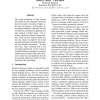Free Online Productivity Tools
i2Speak
i2Symbol
i2OCR
iTex2Img
iWeb2Print
iWeb2Shot
i2Type
iPdf2Split
iPdf2Merge
i2Bopomofo
i2Arabic
i2Style
i2Image
i2PDF
iLatex2Rtf
Sci2ools
EMNLP
2009
2009
Less is More: Significance-Based N-gram Selection for Smaller, Better Language Models
The recent availability of large corpora for training N-gram language models has shown the utility of models of higher order than just trigrams. In this paper, we investigate methods to control the increase in model size resulting from applying standard methods at higher orders. We introduce significance-based N-gram selection, which not only reduces model size, but also improves perplexity for several smoothing methods, including Katz backoff and absolute discounting. We also show that, when combined with a new smoothing method and a novel variant of weighted-difference pruning, our selection method performs better in the trade-off between model size and perplexity than the best pruning method we found for modified Kneser-Ney smoothing.
| Added | 17 Feb 2011 |
| Updated | 17 Feb 2011 |
| Type | Journal |
| Year | 2009 |
| Where | EMNLP |
| Authors | Robert C. Moore, Chris Quirk |
Comments (0)

